Over the last several years, we’ve seen organizations increasingly invest in efforts to better listen and respond to the needs of customers and employees. While organizations often prioritize these Experience Management (XM) activities to drive short-term value, we’ve observed that they are actually part of a much larger transformation happening across every industry and geographic region… one that most leaders haven’t yet recognized. As organizations gain better access to human insights, they start embarking on an evolution:
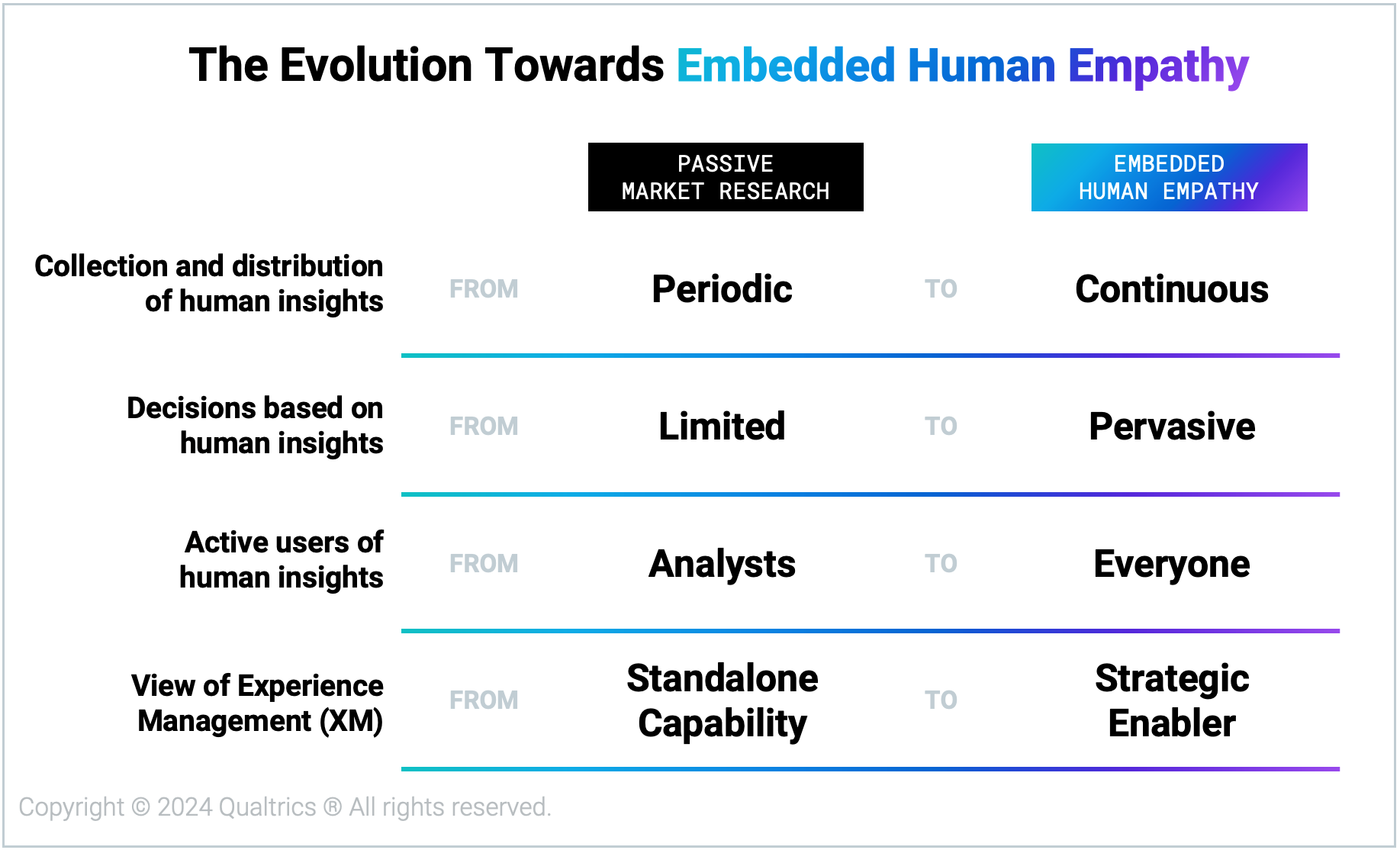
- From: Passive Market Research. Looking back five years, most organizations had little insight into what people were thinking and feeling. If they wanted to learn about customers, prospects, or employees, they would deploy a research project. These were either ad-hoc projects or periodic activities like annual or bi-annual customer satisfaction or employee engagement studies. These efforts were led by an internal or external research group who – after a few months of survey design, execution, and analysis – would deliver the results in the pages of a report. A handful of people would review this static document… and then set it aside.
- To: Embedded Human Empathy. As we look ahead over the next decade, organizations will be collecting and analyzing human-centric insights from their key stakeholders on an ongoing basis and delivering actionable insights within the normal workflow and systems that employees use as part of their day-to-day operations. People across an organization will not only have access to a deep understanding of what customers, prospects, and employees are thinking and feeling, but these insights will be merged with operational and behavioral data to deliver recommended actions. Every enterprise system will use these insights to either automate activities or empower employees.
Heading Towards Embedded Human Empathy
Organizations aren’t being drawn towards Embedded Human Empathy because of an altruistic goal to better serve human beings. Instead, they increasingly realize the immense value they can unlock with a stronger, more real-time view of what customers and employees are thinking, feeling, and doing. Ultimately, it’s about creating the foundation for making faster, smarter decisions.
While the value of this shift is compelling on its own, we see several factors that are accelerating this transformation. These favorable tailwinds include:
- Maturing XM skills. XM is still a young profession. With the establishment of the Customer Experience Professionals Association in 2011, XM was launched as a professional discipline. Since then, the number of people who have entered the field has grown dramatically, especially as employee experience professionals have joined the mix. Not only are we seeing more XM professionals develop their skills, but their ability to use human insights to drive action continues to improve as they uncover and share best practices.
- Expanding XM platforms. Many XM technologies started as tools for helping analysts design, deploy, and analyze surveys. Over the years, these systems have become more like enterprise applications, using insights to fuel workflows based on human insights. The Qualtrics XM Platform, for instance, now triggers more than five billion actions per year and leverages XM Discover to process more than three billion pieces of unstructured content, like contact center conversations and social media posts.
- Emerging Gen AI capabilities. Gen AI is a very disruptive technology. Although it’s unlikely to live up to all the hype in the short run, it will eventually touch just about every activity in our lives. While the technology has a vast number of capabilities, we believe that these four capabilities of Gen AI will be particularly valuable in accelerating XM efforts: data summarization, pattern recognition, conversational interface, and content personalization.
- Increased uncertainty. Whether it’s from political conflict, environmental catastrophes, disease outbreaks, or economic disruptions, organizations today need to plan for unplanned events. The only thing they can be certain about is that they will need to deal with a lot of uncertainty. In this environment, XM becomes even more important as it helps organizations build the agility to quickly sense and respond to changes.
The Evolution Blueprint: Modern XM
While XM efforts today can effectively propel organizations beyond Passive Market Research, they are not yet set up to reach the ultimate destination: Embedded Human Empathy. To achieve the next phase of this evolution, organizations need to focus on building what XM Institute calls, “Modern XM.”
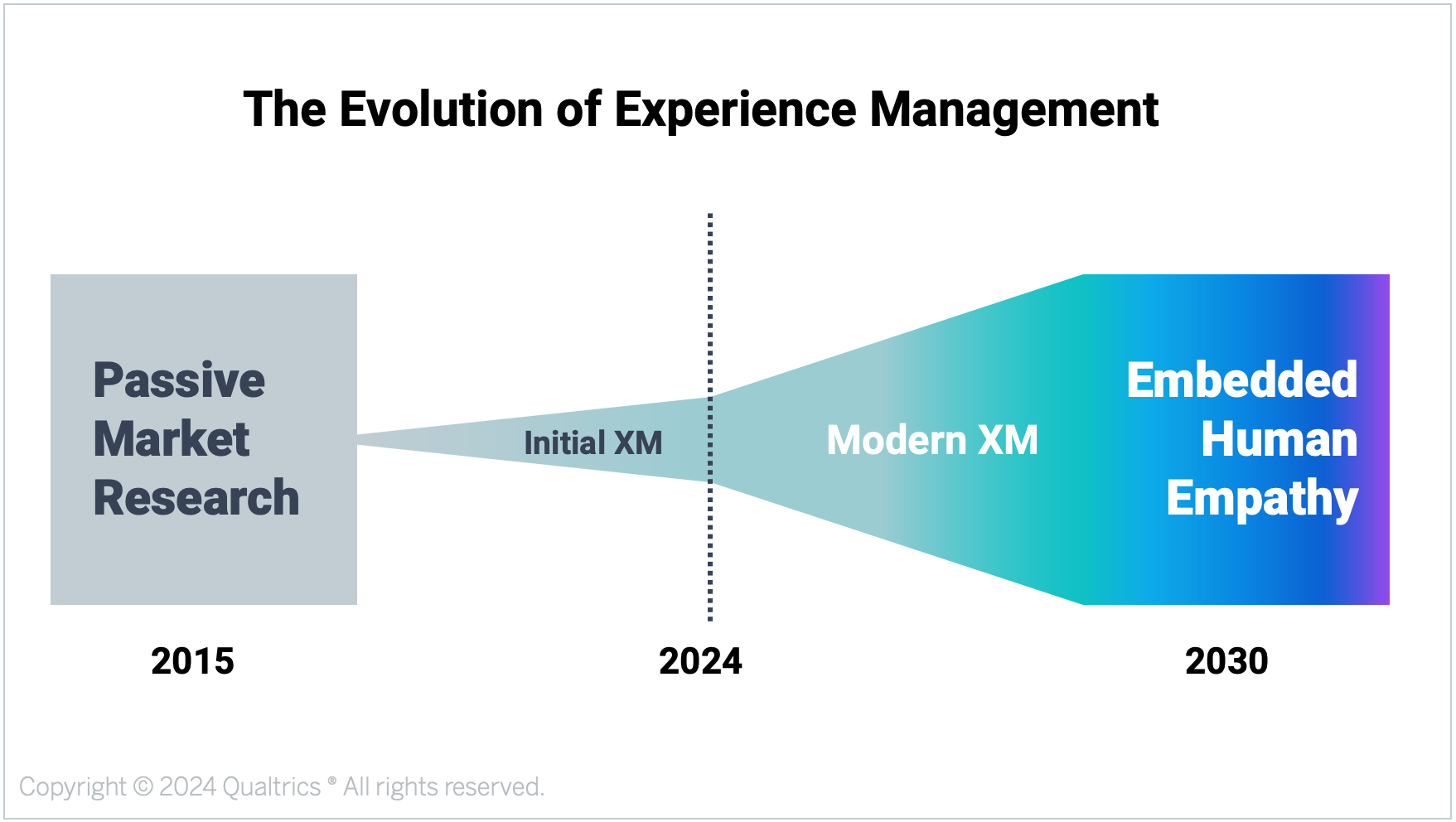
To understand Modern XM, it’s important to recognize the three capabilities that form the foundation of any successful XM program:
- Continuously Learn. XM enables organizations to more effectively sense and interpret what’s going on all around them, collecting and analyzing signals from the actions and feedback of employees, partners, vendors, customers, and even competitors.
- Propagate Insights. XM helps organizations get actionable intelligence into the hands of the people across their ecosystem who can use it, creating seamless access to the right information in the right form at the right time.
- Rapidly Adapt. XM allows organizations to act on the insights they’ve uncovered at an increasingly fast pace, finding ways to create exceptional new experiences and enhance existing ones.
Components of a Modern XM Program
The blueprint for Modern XM is merely a modernization of these three core XM capabilities. Over time, we expect that organizations will increasingly enable:
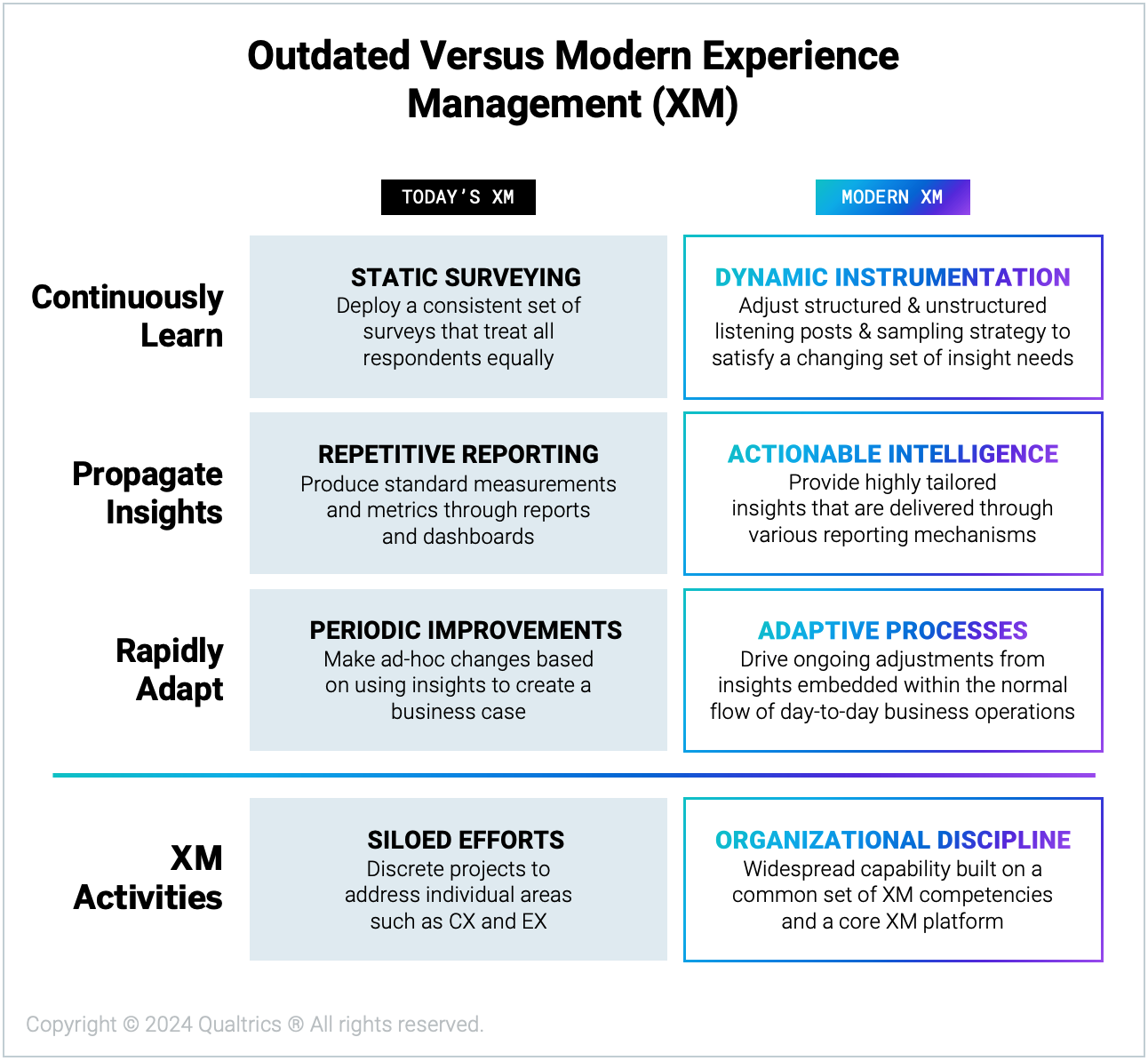
- Dynamic Instrumentation. Organizations today often deploy a consistent set of surveys to the same grouping of people. This static approach breaks down as an organization’s priorities and operating environments change over time. Modern XM efforts take into account the organization’s shifting priorities, adjusting their solicited and unsolicited listening posts as well as their sampling criteria in order to meet a changing set of needs.
- Actionable Intelligence. Organizations often invest considerable energy into producing standard measurements through reports and dashboards. Metrics can be valuable, but only when they lead to improvements. Instead of this repetitive reporting on past activities, Modern XM efforts focus on the future by providing highly tailored actionable insights that are delivered through various push-and-pull mechanisms. As the combination of behavioral, operational, and experience (BOX) data grows, they use more advanced and automated analytics to uncover important and emerging patterns in both structured and unstructured data.
- Adaptive Processes. Most organizations use their XM-based insights to develop the business case for making changes. But these periodic improvements only capture a very small fraction of the potential value. As the flow of actionable insights increases, organizations will differentiate themselves based on their ability to quickly absorb and respond to them. This isn’t about adding more items to a prioritized wish list. It’s about embedding insights within the normal flow of day-to-day operations. To do this at scale, organizations set up automatic workflows triggered by these insights.
In order to deliver these modernized capabilities, we expect XM activities to evolve into an:
- Organizational Discipline. Organizations often start their XM journeys with a set of siloed projects, without making any real connections across adjacent areas, such as digital and contact center use cases or customer and employee experiences. Instead, these groups work in isolation, using various systems to do very similar types of activities. While these disparate efforts can be valuable on their own, they don’t deliver the type of pervasive change that comes from leveraging and enhancing a set of XM capabilities across the entire organization. Modern XM efforts establish a widespread and ingrained capability built on a common set of XM competencies and a core XM platform.
How to Build a Modern XM Program
To help organizations accelerate their path towards Modern XM, we’ve outlined some of the key underlying shifts they will need to make to build each of the three core XM capabilities.
Modern XM Capability: Dynamic Instrumentation
Data is the fuel powering organizations’ evolution towards Embedded Human Empathy. Historically, if organizations wanted to understand how people felt about their experiences, they would deploy a generic, static survey triggered at predetermined points along someone’s journey. While surveys can be a useful source of experience data, issues like limited scope, low response rates, and data lags ultimately inhibit their ability to drive continuous, human-centric decisions across the organization.
Instead of this rigid, survey-based approach to customer and employee listening, organizations need to build an agile, responsive listening infrastructure – one that is capable of adapting both its listening posts and its sampling strategy to capture a continuous flow of XM data that reflects the ever-evolving needs of both individuals and the business. This shift from static surveying to Dynamic Instrumentation requires three shifts:
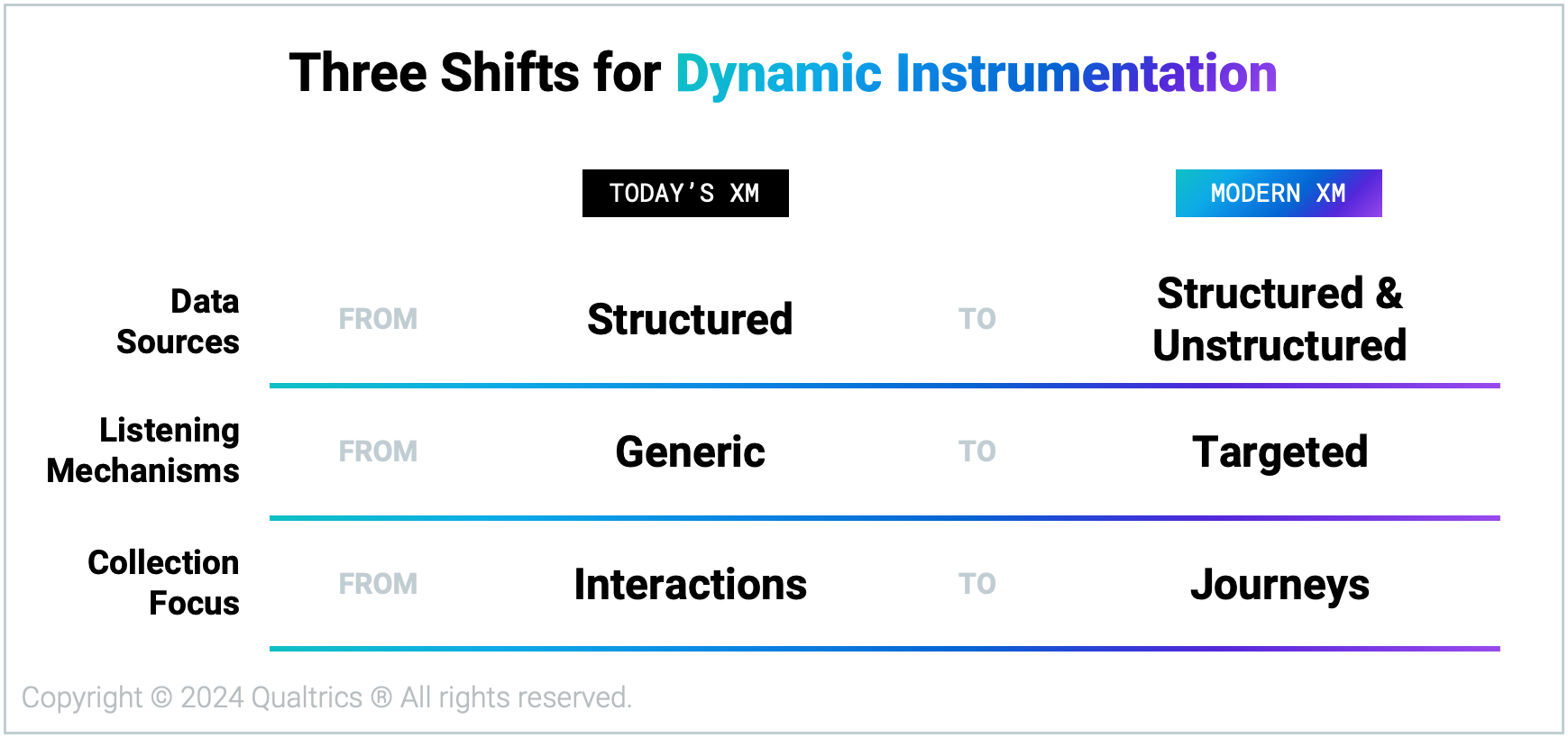
- Data sources evolve from structured to structured & unstructured. Most experience data today comes from structured data captured through solicited surveys, occasionally paired with some basic operational data from enterprise applications like CRM and HCM. Although structured data points are easy to analyze, manage, and maintain – which can provide value, especially in early XM stages – their fixed format limits their ability to explain complex relationships or explain why something happened. Unstructured data, by comparison, is emotion-rich, flexible, and captures people’s experiences in their own words, making it essential for Embedded Human Empathy. A modern XM program can ingest experience, behavioral, and operational data in unstructured formats from both solicited and unsolicited listening channels. The exact combination of XM data types will vary, but it can include open-ended text from sources like social media posts, third-party review sites, and contact center transcripts as well as videos (e.g., digital session replays, product reviews on Youtube), images (e.g., screenshots, photos), and audio (e.g., call center recordings, exit interviews recordings).
- Listening mechanisms evolve from generic to targeted. XM programs’ listening efforts today tend to treat every customer or employee the same, regardless of that individual’s journey, segment, preferences, or real-time behaviors. They deploy identical, generic surveys at specific points along a journey, resulting in delayed insights based on a random, limited sample. A modern XM program, on the other hand, implements personalized and targeting listening strategies for specific audience segments based on a variety of different triggers. It can dynamically adjust the questions, channels, and timing of its feedback requests, tailoring the content and form of the survey to produce personalized, always-on insights. While this might start with some behavior-based triggers – such as rage clicking, activating in-app geofencing, or completing a training – as XM programs’ technology and practices become more mature, they are able to fine-tune feedback requests based on an increasingly nuanced understanding of who each individual is, the real-time context surrounding their interactions, and the current needs and priorities of the business. Ultimately, this adaptive targeting enables XM programs to capture the specific data they need to fuel their most important decisions and actions.
- Collection focus evolves from interactions to journeys. Organizations today often take a disjointed, inside-out approach to listening-post design. They establish collection mechanisms at moments that matter to an internal team – such as marketing, product, sales, or benefits – rather than to customers or employees. These teams then examine the XM data collected in isolation without considering the broader context surrounding that interaction, resulting in a fragmented view of people’s experiences. A modern XM program, by comparison, anchors its listening strategy in an end-to-end journey perspective, including steps that don’t include organization. It uses journey maps as a blueprint for planning out all its different listening posts, ensuring it collects the right mix of XM data during “moments that matter” (the moments of greatest emotional intensity with the most outsized impact on loyalty) as well as at the end of key journeys.
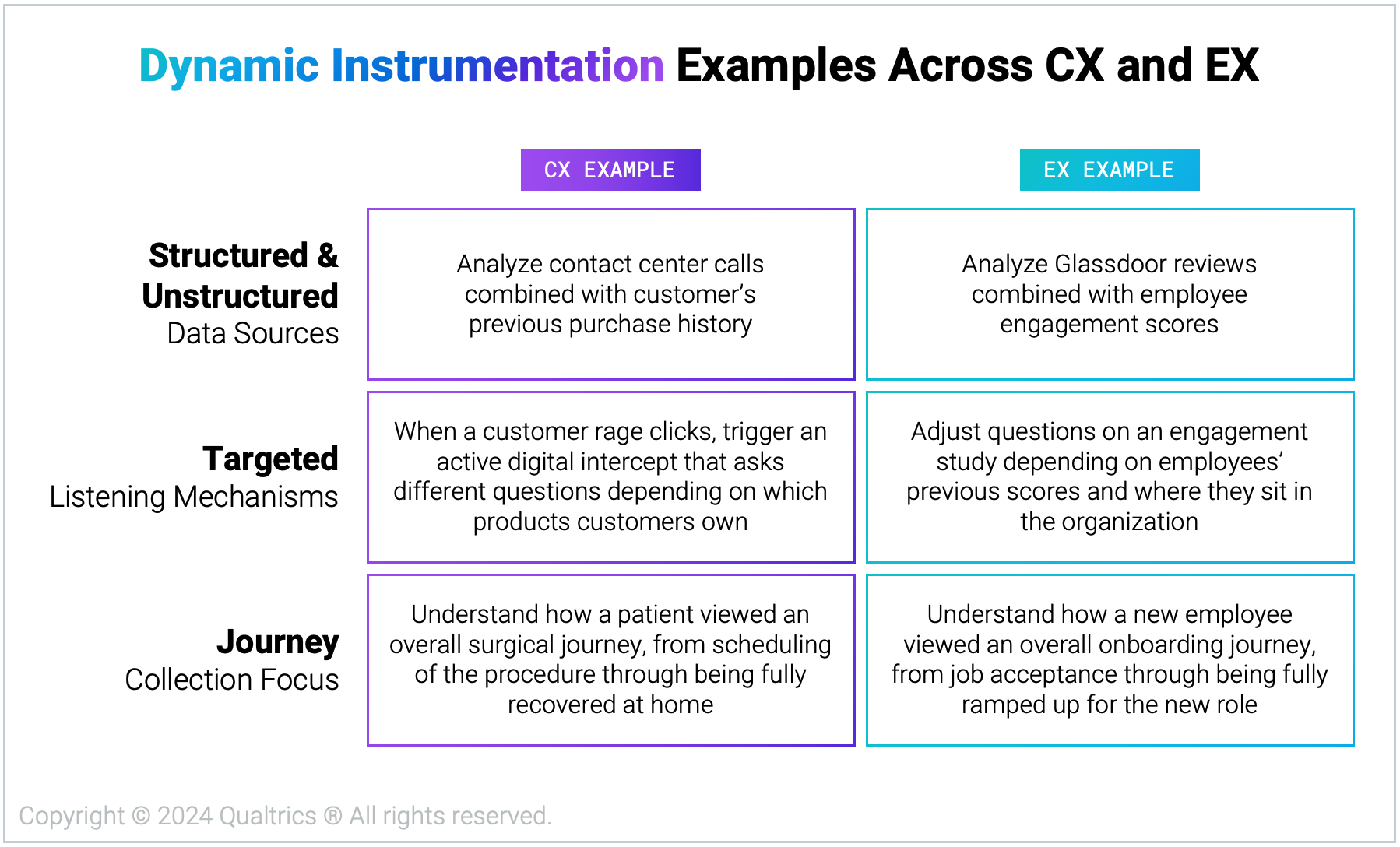
Modern XM Capability: Actionable Intelligence
Most XM programs today focus on producing a standard set of metrics that track customers’ or employees’ past behaviors and perceptions. They then periodically analyze and share these scores with a select group of stakeholders – often in the form of static reports or spreadsheets. While these repetitive reporting activities can help early-stage XM programs develop and communicate a baseline understanding of current experiences, infrequent insights will ultimately only lead to infrequent experience improvements.
XM programs should instead use these insights to weave a deep understanding of human beings into their organization’s culture and its operating processes. This starts with applying advanced, automated analytics to the XM data they’ve captured, transforming isolated data points into an ongoing flow of predictive, prescriptive, and personalized insights. They should then distribute these insights across the organization through a variety of highly tailored and timely formats that are embedded within the systems people use as part of their everyday roles. Generating and sharing Actionable Intelligence requires three shifts:
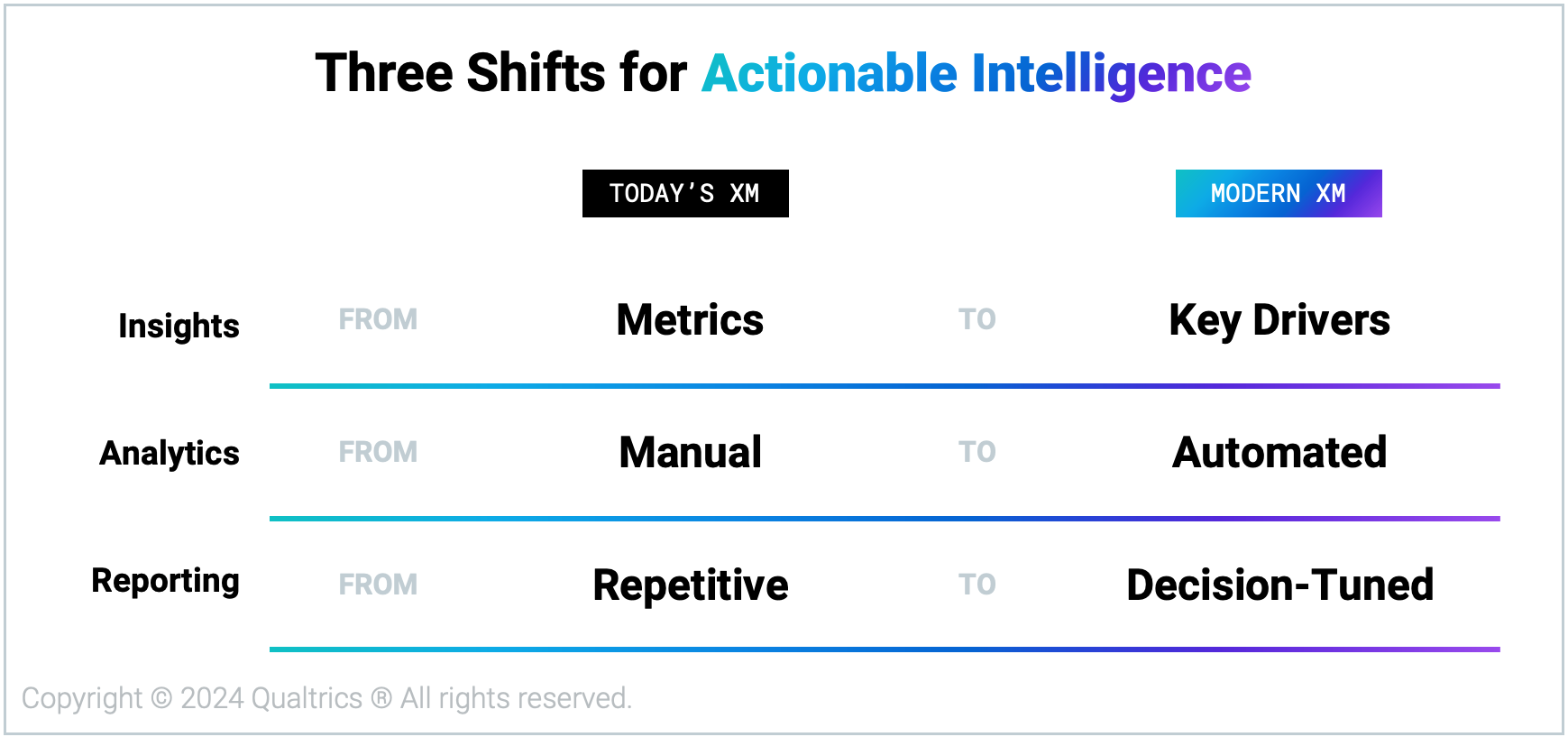
- Insights evolve from metrics to key drivers. Many XM programs today collect XM metrics – such as NPS, employee engagement, satisfaction, and effort measurements – to track historical trends and compare themselves to competitors. While these metrics can provide a useful snapshot of an organization’s XM performance, tracking these numbers alone does not help identify where to drive improvements. Rather than obsess over the metric itself, modern XM programs use the insights they collect to identify and model the specific factors influencing those customer or employee perceptions, and by extension, their behaviors and the business’s bottom line. They uncover these key experience drivers through a mix of qualitative insights (e.g., stakeholder interviews, user research) and quantitative modeling (e.g., correlation, regression, or linkage analyses), which enables them to pinpoint which factors have the most significant impact on important business and experience outcomes. The XM program then uses these insights to shape its strategy, prioritize and plan activities, share prescriptive advice, and develop compelling value narratives around its efforts.
- Analytics evolve from manual to automated. Historically, XM programs required trained data scientists to hunt down and manually connect the behavioral, operational, and experience datasets they need to build their models, making analysis expensive and laborious. As the volume and variety of BOX data grows, XM programs need to invest in the technologies and capabilities that allow them to automate and accelerate insights discovery. Modern XM programs have a powerful set of analytics in place, which include statistical tools – such as driver analysis, significance testing, journey analytics, and weighed insights – as well as more advanced analytics, like predictive modeling, conjoint, video analytics, and Generative AI. These tools tap into increasingly sophisticated artificial intelligence and machine learning capabilities to automate a variety of activities, including surfacing patterns and trends, proactively flagging issues and opportunities, building a deeper understanding of individuals and segments, and triggering actions and workflows.
- Reporting evolves from repetitive to decision-tuned. Embedded Human Empathy requires organizations to share human-centric insights that are contextualized for specific roles and presented in a way that is intuitive and easy for users to act on. Most XM programs today publish periodic XM insights through reports or dashboards that aggregate data without any context or guidance. Modern XM programs, by contrast, distribute highly tailored, real-time intelligence specifically designed to support the activities and decisions of insights users. They distribute this intelligence through a number of different channels – like reports, dashboards, and alerts – that are embedded within the systems and applications insights users already access as part of their everyday activities. These reporting mechanisms do more than describe findings; they proactively highlight key patterns, issues, and opportunities. This helps users anticipate future events, identify effective actions, and prioritize tasks.
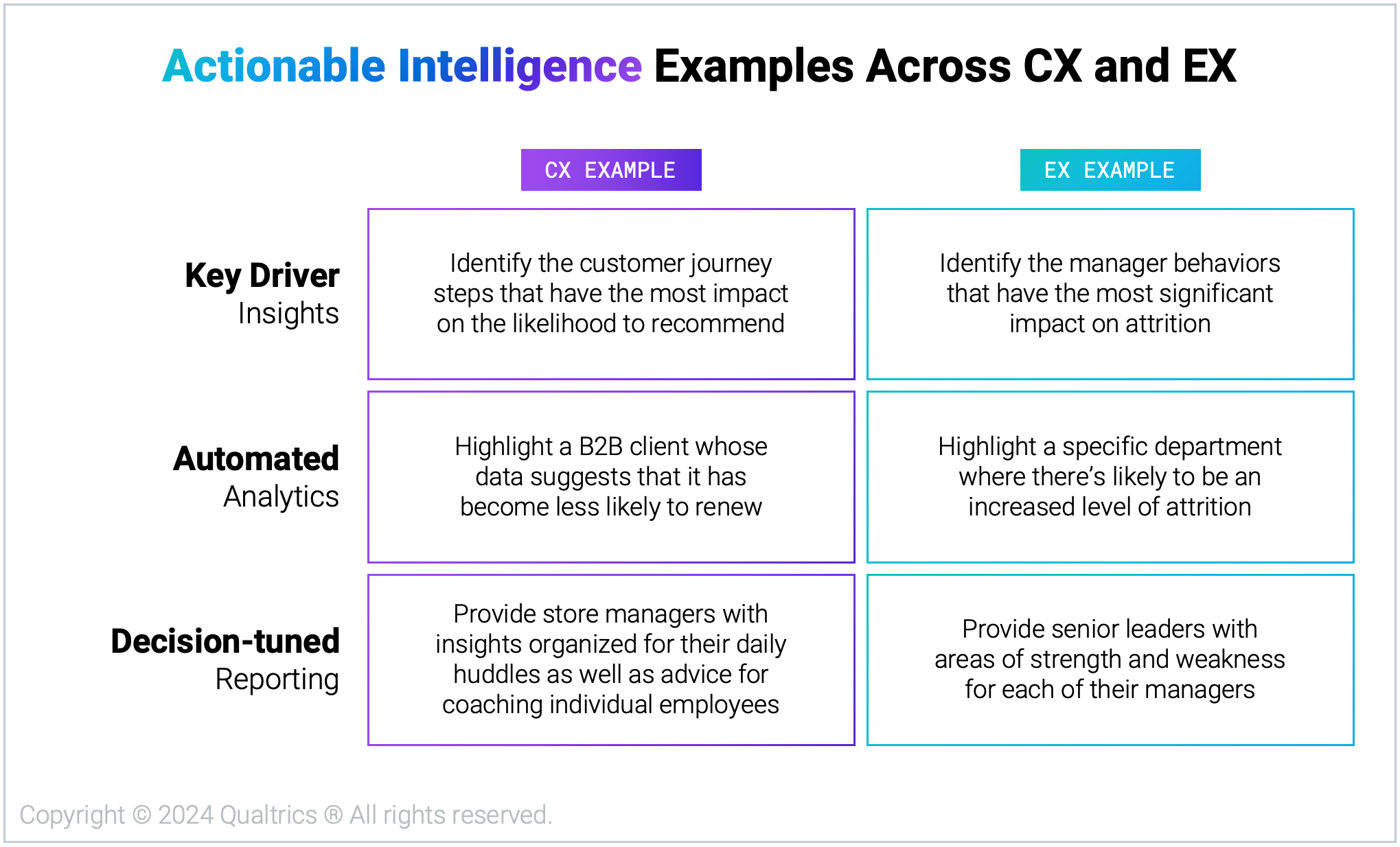
Modern XM Capability: Adaptive Processes
Given Experience Management efforts only generate value when they drive action, XM programs should be optimized to facilitate and support those actions. Instead, most organizations today focus their XM activities primarily on the collection and dissemination of metrics. At best, they use the insights they produce to make the case for investing in some standalone, ad-hoc changes. While these periodic improvements can lead to incremental gains, they only capture a very small fraction of the potential value from XM.
As the volume and actionability of insights increase, leading organizations will allot more of their attention to putting those insights to better use. Rather than just finding and fixing problems, Modern XM efforts will embed human-centric insights into an organization’s operating rhythm, looking for opportunities to uncover novel segmentations, trigger automated workflows, and build innovative processes and offerings. These changes will enable an organization to automatically tailor experiences to meet the unique needs of different people, including customers, employees, and partners. Building Adaptive Processes requires three shifts:
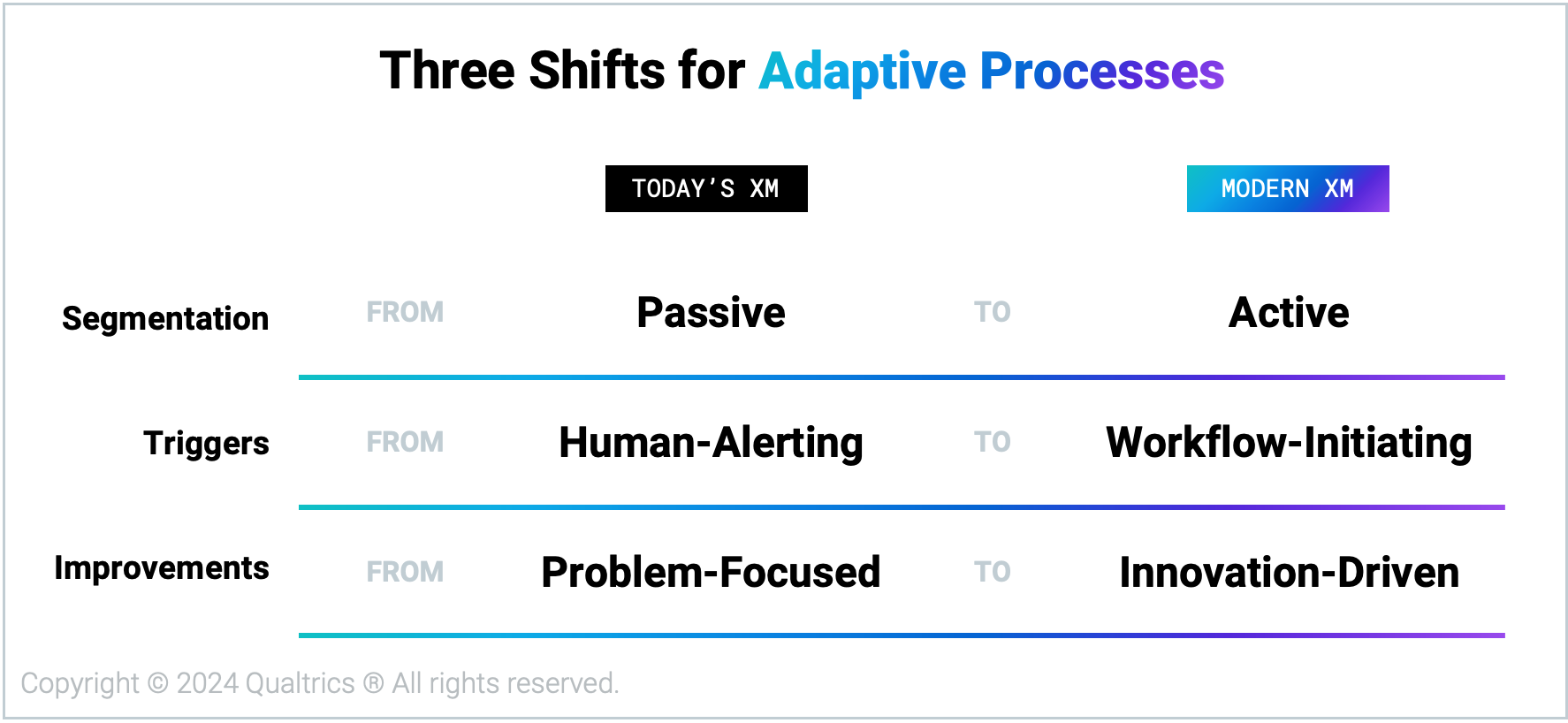
- Segmentation evolves from passive to active. Most organizations today build basic, static segmentation models that are built on simple demographic and profile information, such as an individual’s age, region, department, loyalty tier, or product portfolio. While this information can be helpful early on, these attributes are often not the defining characteristics that shape someone’s needs or perceptions of their experiences. They can also often lose relevance over time. Other behavioral or psychographic traits – like someone’s goals, attitudes, skills, motivations, values, habits, fears, or personality – can be more predictive of someone’s response to an experience. Rather than passive, demographic-based segmentation models, a modern XM program creates profiles of individual customers or employees. These profiles combine structured and unstructured BOX data from the person’s interactions with the organization, and they add in both real-time context and relevant analytics. Bringing all this individual-level data together in one place allows the XM program to build rich, dynamic segments, which it can then use to tailor interactions based on someone’s unique behavior, needs, and context.
- Triggers evolve from human-alerting to workflow-initiating. Many XM programs have some triggers in place to notify relevant stakeholders about a specific piece of feedback or data, such as informing an account manager when a B2B client gives a low Net Promoter Score or telling a manager when one of their reports feels low levels of belonging. However, most of these triggers today are focused on alerting rather than action. As the volume of actionable intelligence increases, modern XM programs establish systems of automated workflows that are triggered by a variety of data elements and analytics. These workflows drive Embedded Human Empathy by automatically routing relevant insights to the appropriate stakeholders within the systems and processes they already use as part of their role (e.g., email, Jira, Slack, Salesforce, VoC program dashboard, etc.). And then these workflows don’t just pass along information, they also initiate activities that don’t require manual interventions, such as scheduling a coaching session between a supervisor and a call center agent whose empathy scores are trending down or initiating a ticket for a service call with a customer who has complained several times about a major appliance.
- Improvements evolve from problem-focused to innovation-driven. XM programs today often collect XM insights with the goal of finding and fixing existing experience gaps and pain points. While this does lead to incremental improvements, reactive firefighting doesn’t help the organization create exceptional experiences that capture people’s hearts and minds and set it apart from competitors. Modern XM programs uncover people’s unmet needs and provide the insights necessary to craft and deliver highly differentiated offerings that satisfy those desires. Their efforts fuel modernized human-centered design processes, which use XM insights to continuously uncover, test, and iterate on new products, services, and experiences. For example, an electronics manufacturer could source ideas for new features by regularly scraping unstructured data from social channels, review sites, and support interactions. A software company, meanwhile, could accelerate the rollout of new offerings by using rapid experimentation to optimize minor product variations and then actively adjusting launch messaging based on the real-time reactions of target customers.
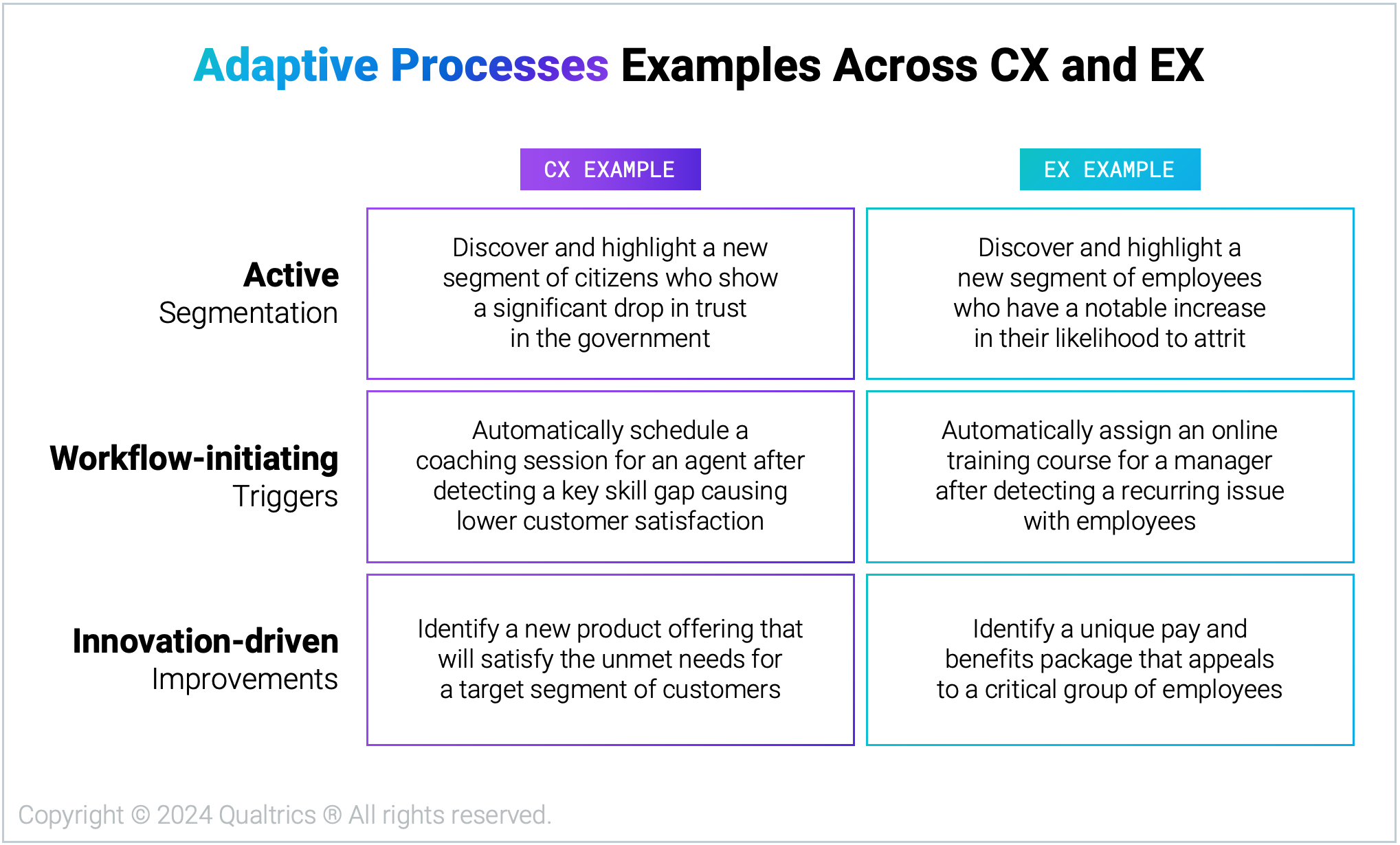
Modern XM Requires Building an Organizational Discipline
Current XM efforts tend to splice together siloed initiatives and isolated projects, which is appropriate in a world of Passive Market Research. However, to enable Dynamic Instrumentation, Actionable Intelligence, and Adaptive Processes, organizations will need to establish widespread capabilities that are built on a common set of XM competencies and a core XM platform. This next phase of evolution to Modern XM will require organizations to advance all three aspects of the XM Operating Framework:
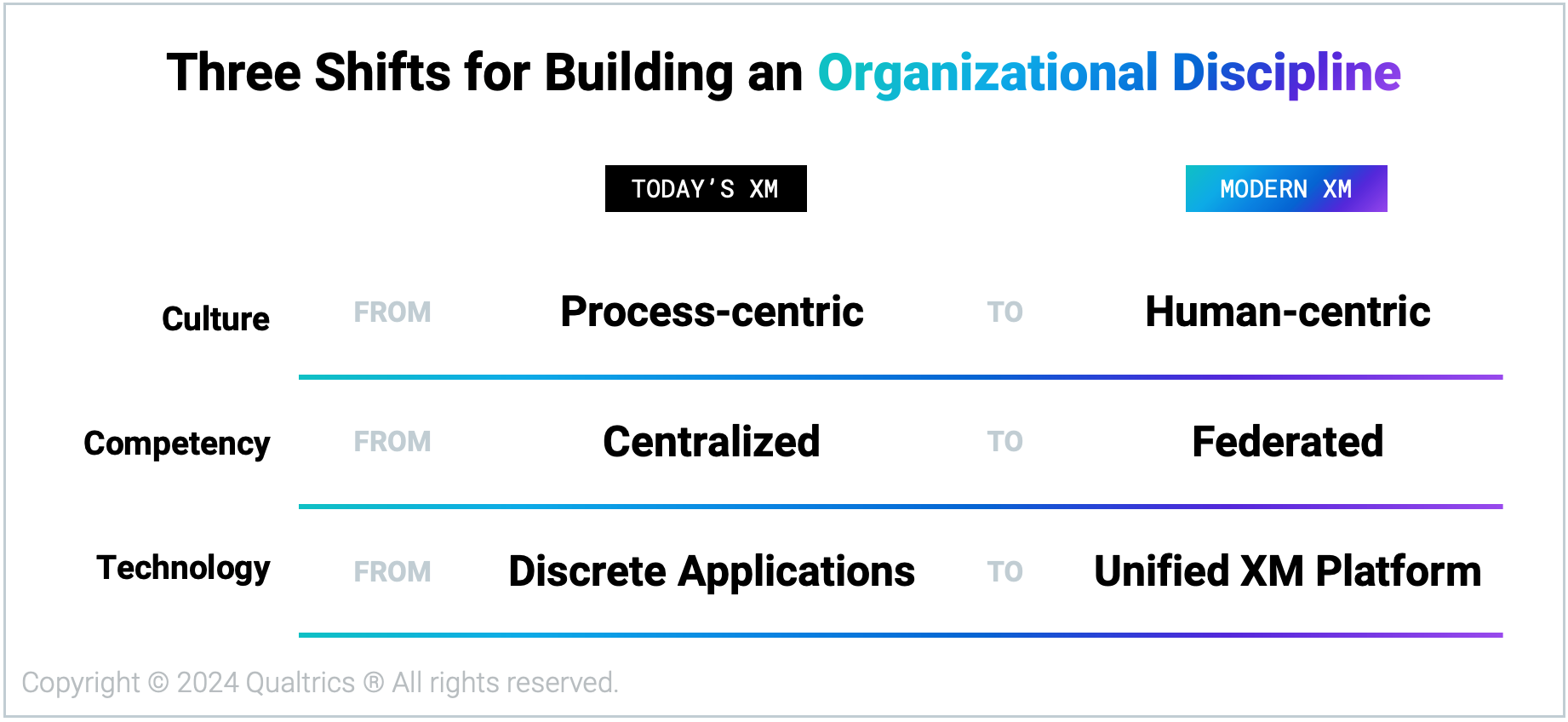
- Culture evolves from process-centric to human-centric. Organizations’ decisions today are largely driven by data about operational processes. However, as they build their Modern XM capabilities, large numbers of employees will gain access to insights about what people are thinking, feeling, and doing. These human-centric insights will naturally push organizations to demonstrate increased empathy for customers and employees. In a Human-Centric culture, the organization recognizes that business success is driven by engaged employees and loyal customers, so it treats employees as critical assets who need to feel engaged and customers as human beings who need their emotional needs met.
- Competencies evolve from centralized to federated. XM programs today tend to have pockets of good customer or employee experience practices underway, but they are led by different groups and focused heavily on data gathering and analysis. As the XM efforts mature, they build strong centralized groups to create standards and establish centers of excellence (CoE). Although these core groups are valuable, a modern XM program focuses heavily on driving faster, smarter decisions and actions throughout the business. It does this by spreading the Six XM Competencies — Lead, Realize, Activate, Enlighten, Respond, and Disrupt — across the entire organization, ensuring that these capabilities are localized and embraced by everyone.
- Technology evolves from discrete applications to a unified XM platform. Most organizations today collect and process their customer or employee experience data in different business systems, each of which is owned and managed by a different team. Housing this data in different applications limits an XM program’s ability to scale XM practices and capabilities consistently across the organization. In the same way that organizations have enterprise applications for many of their core activities – like finance, HR, sales, and marketing – they need an enterprise application capable of handling the growing volume of experience data they collect and process. Because a modern XM program recognizes that experience data is a key strategic asset for the business, it feeds it into a single, accessible, pervasive XM platform, where it can be easily accessed and integrated with other enterprise systems, generating a continuous flow of highly actionable insights.
Three Stages of XM-Driven Business Transformation
As organizations modernize their XM efforts and start embedding human empathy across every part of their organization, they will find that these capabilities provide the foundation for radically improving every aspect of how they operate, not just managing people’s experiences. While XM efforts may have started with a focus on data and insights, they will eventually lead to large-scale business transformations. But this change will not happen all at once. We expect that organizations will evolve through a three-stage transformational journey:
- Stage 1: Insight Infusion. In the initial stage of XM deployment, organizations add insights into existing processes and decision-making workflows. They tap into the value of more numerous and enhanced listening posts, like voice of the customer programs, employee census, and brand trackers. These insights help the organization identify opportunities for improvement and build empathy for key audiences. In this stage, people don’t change what they do but instead use insights to perform existing activities better. For instance, front-line managers will tap into customer insights to make their daily huddles more relevant, and customer success groups will use richer insights to improve their quarterly business reviews with clients.
- Stage 2: Operational Transformation. After getting more comfortable using insights within existing operations, leaders across an organization will reimagine their workflows to more effectively tap into the increasing flow of insights. For instance, contact center managers may redesign their coaching models to focus on the most compelling customer issues, and product owners may reserve some ongoing capacity in development sprints to focus on features identified through a combination of social comments and an employee feedback idea board.
- Stage 3: Competitive Reinvention. Once organizations evolve through the initial two stages of XM transformation, they will recognize opportunities to tap into insights in even more substantial ways. Instead of using XM to improve existing workflows and operational processes, they’ll completely rethink what they do and how they do it, using XM as a highly empowering, underlying infrastructure for their entire operating model. For instance, a large traditional bank that becomes XM-Powered may create a new digital offering that targets entirely new segments of customers with highly tailored brand messages and experiences, while adjusting its employee hiring and development processes.
The bottom line: Modern XM is the roadmap for your journey towards Embedded Human Empathy.
Bruce Temkin, CCXP, XMP, is Head of Qualtrics XM Institute
Isabelle Zdatny, CCXP, XMP, is the Head of Thought Leadership for Qualtrics XM Institute





